The Sliding Sands Trail, officially named the Keonehe’ehe’e Trail, provides unparalleled access to and views of the otherworldly landscape of Haleakalā National Park’s volcanic crater in Maui. A portion of Keonehe’ehe’e (Sliding Sands) Trail is frequently combined with a portion of the Halemau’u trail to create an epic 11 mile (17.8 km) day-hike, but segments of the trail can also be hiked as shorter out-and-backs or combined with other trails within the crater to form a longer multi-day backpacking itinerary.
We hiked this trail as the first leg of three night/four day backpacking trip into the dormant volcanic crater.
Table of Contents
Planning your own trip to Haleakalā? Check out our Guide to Backpacking inside Haleakalā National Park
Sliding Sands Trailhead to the Crater Floor
After watching the sunrise from the crater rim (another must-do experience), we parked back at the Halemau’u trailhead, gathered our gear, and quickly made our way down a very short connector trail to the Hiker Pick Up area, where we waited for a hitch back to the top. Hitchhiking is legal within Haleakalā, and is the officially sanctioned and ranger recommended way to complete not only the backpacking circuit but also the rigorous day hike between the Sliding Sands and Halemau’u trailheads.
Given that it was Thanksgiving morning when we started our trip, and most visitors were now exiting the park having already seen the sunrise, we were rather anxious about getting a ride. So anxious that we rushed through our standard “final check” process of ensuring nothing was being left behind in the vehicle (wouldn’t realize the fully ramifications of that until later, alas!). But fortunately for us, the Haleakalā Observatory was not shut down for the holiday. A civilian employee of Space Force picked us up on his way to work after only a five minute wait.

The Keonehe’ehe’e (Sliding Sands) Trail begins at the summit area Visitor Center parking lot. From there, it descends roughly 4 miles into the crater. Though a few hundred feet lower than the official summit, it’s still an impressive 9,730 ft in elevation.
From the start, you can see the trail wind around the upper rim of the crater in one long, slow arc, before descending down to the base of the crater in a series of switchbacks.
Click on galleried photos to enlarge and view as a full-screen slideshow.


At every angle, a different series of features would come into view. To the left, looking north, you can see Ko’olau Gap, where the mountain seems to disappear into a bed of clouds, and Kalahaku Pali, pali meaning cliffs.



As we descended, the cinder cones within the crater slowly became more visible. The green cliffs of Kalapawili Ridge off in the distance, towering over our day one destination of Palikū, slowly appeared more verdant as the sun rose higher into the sky.
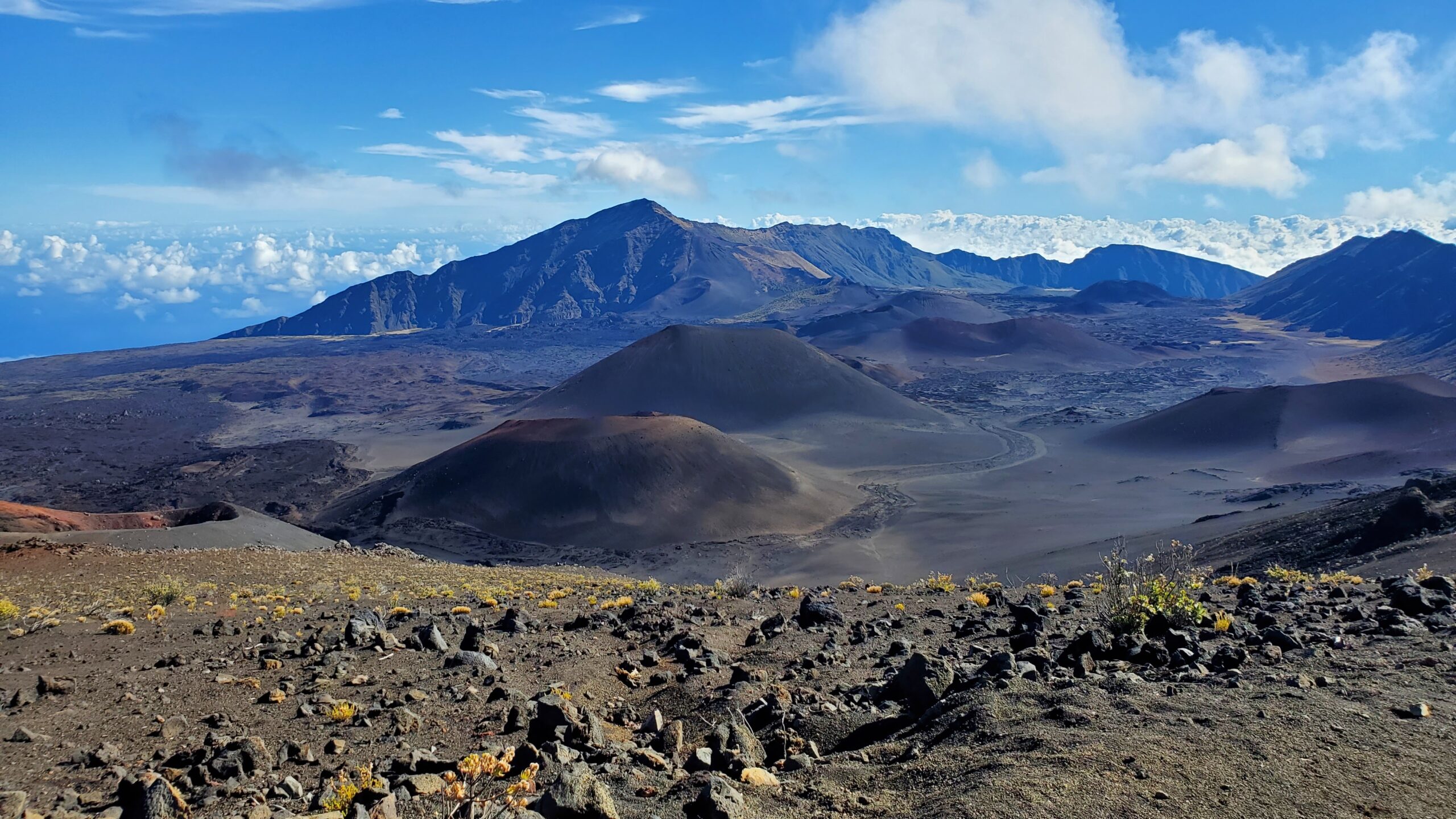
A mile or so in, the trail enters a series of long switchbacks, lined off to either side with variously hued volcanic rock.
The crater ecology of this entire section is considered an alpine aeolian desert, distinguishable by the rocky, lunar landscape, shaped by the wind. It felt special to be in such a unique space. It’s been nicknamed the “quietest place on earth” and it really did feel like we were in another world. With no bird song, no breeze, and few other hikers on the trail, there was only the crunch of our boots against the cinder dust of the trail.






Only a few species of endemic plants survive in the harsh terrain, the most recognizable are the kūpaoa (Dubautia menziesii) – a desert shrub – and the famous ‘ahinahina, or Haleakalā silverswords.
This is the only place in the world that the Haleakalā silversword is known to exist. Knowing how endangered the species was, it felt surreal to simply walk through dozens of them growing alongside the trail. From a distance, their silvery-white appearance gleams in contrast with the red, black and ochre landscape.


Up close, you can see that this coloration is due to hundreds of tiny hairs on the leaves – most likely an adaptation to the dry climate. These tiny hairs can trap the water droplets from the moisture of clouds.
Silverswords can live upwards of 90 years, and bloom only once in their lifetime, sending up a tall stalk of flowers, reminding me a bit like yuca, before dying. They usually bloom in July, and along the trail we had seen the dried, brown remnants of this past summer’s bloom. Each time I would see the tale-tell stalk in the distance I would pull out the camera lens to see if there was anything that might resemble the blooms, if for no other reason than to be able to say I’d seen one.

We’d been hiking for just over an hour at this point, taking numerous photos along the way. It wasn’t until turning around to take a look back at the silversword grove that it became clear how much elevation we’d already lost. Hiking in had been a “walk in the (national) park”, but hiking out would have a different situation altogether.
At this point, we hadn’t started to feel the effects of the high altitude. On a day hike, it would be very easy to get lulled into a false sense of security and hike beyond one’s preparedness and capabilities. Be smart, carry extra water, and seriously think twice about hiking further than you had planned! It would take 2 – 3 times as long to hike out as it had to hike in.
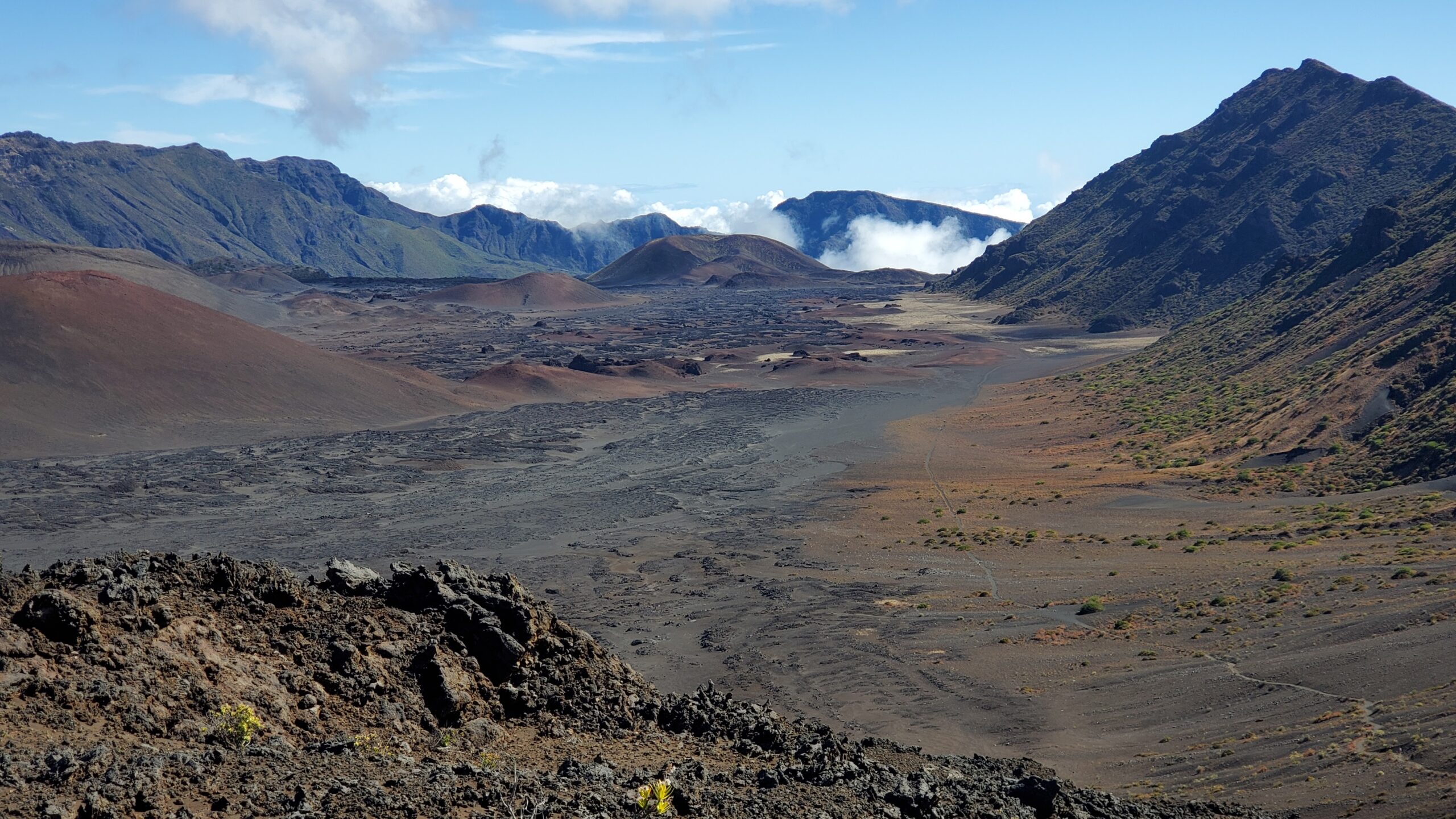
We still had over a mile to go before reaching the base of the crater. Every time we’d reach a flat stretch through the ancient lava bed we’d think “this is it!” only to end up looking out across the crater from the next vista and see the trail continue down, down, down ….


We thought the biggest surprise of the day was going to be the brand new and not yet melted Kit-Kat bar that we found lying in the middle of the trail about 3 miles in. Leave no trace required us to pack it out of the crater regardless, but even better that we got to enjoy a little sweet treat just when we needed a pick-me-up.
But the most unexpected surprise of the day came shortly after reaching the base of the crater – a singular silversword in bloom, right next to the trail! I probably spent a good 15 minutes admiring it from every angle. I’d read that the individual blossoms resemble tiny sunflowers, but their long, sparse petals also reminded me of what asters look like in the early days of their bloom. It was such an surprising color: a deep, magenta.


How a plant like this managed to evolve in this ecosystem is truly fascinating, especially considering that both the silversword and the kūpaoa are both believed to have evolved from the same species that drifted to the Hawaiian islands around 3 million years ago.
Inside a Dormant Volcano
We reached the trail junction and turn-off for the Sliding Sands – Halemau’u Loop hike after about two hours on the trail. The landscape was noticeably different inside the crater floor – grasses replaced the sharp rocky moonscape of the inner rim.


We began referring to this section as “the prairie” even though this ecosystem is more properly a transition from the cinder desert into the subalpine grasslands, featuring a mix of ferns and alpine hair grass (Deschampsia nubigena). We’d now descended nearly 2500 ft to 7400 ft elevation, and both plant and animal life were immediately more abundant. Our presence rousted a number of chukars, small non-native birds, in the ferns.
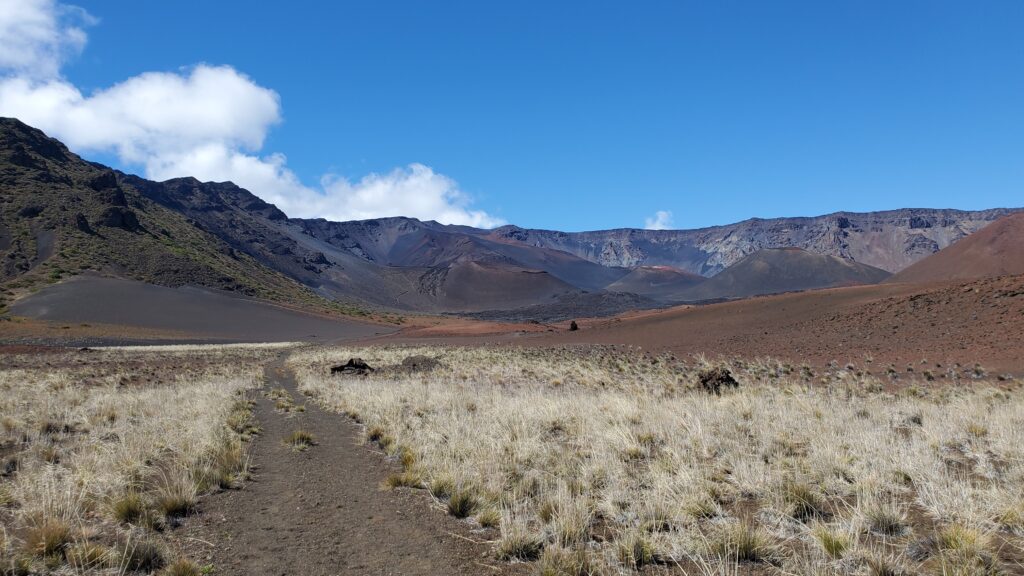
It was only another 1.7 miles to Kapaloa cabin, but it felt like the longest stretch of the entire day. Hiking on soft sand requires a different sort of stamina than the typical dirt of mountain trails. The effects of high altitude hiking were also starting to become noticeable, and the early morning wake-up to see the sunrise combined with the total exposure of the sun now overhead was not helping.
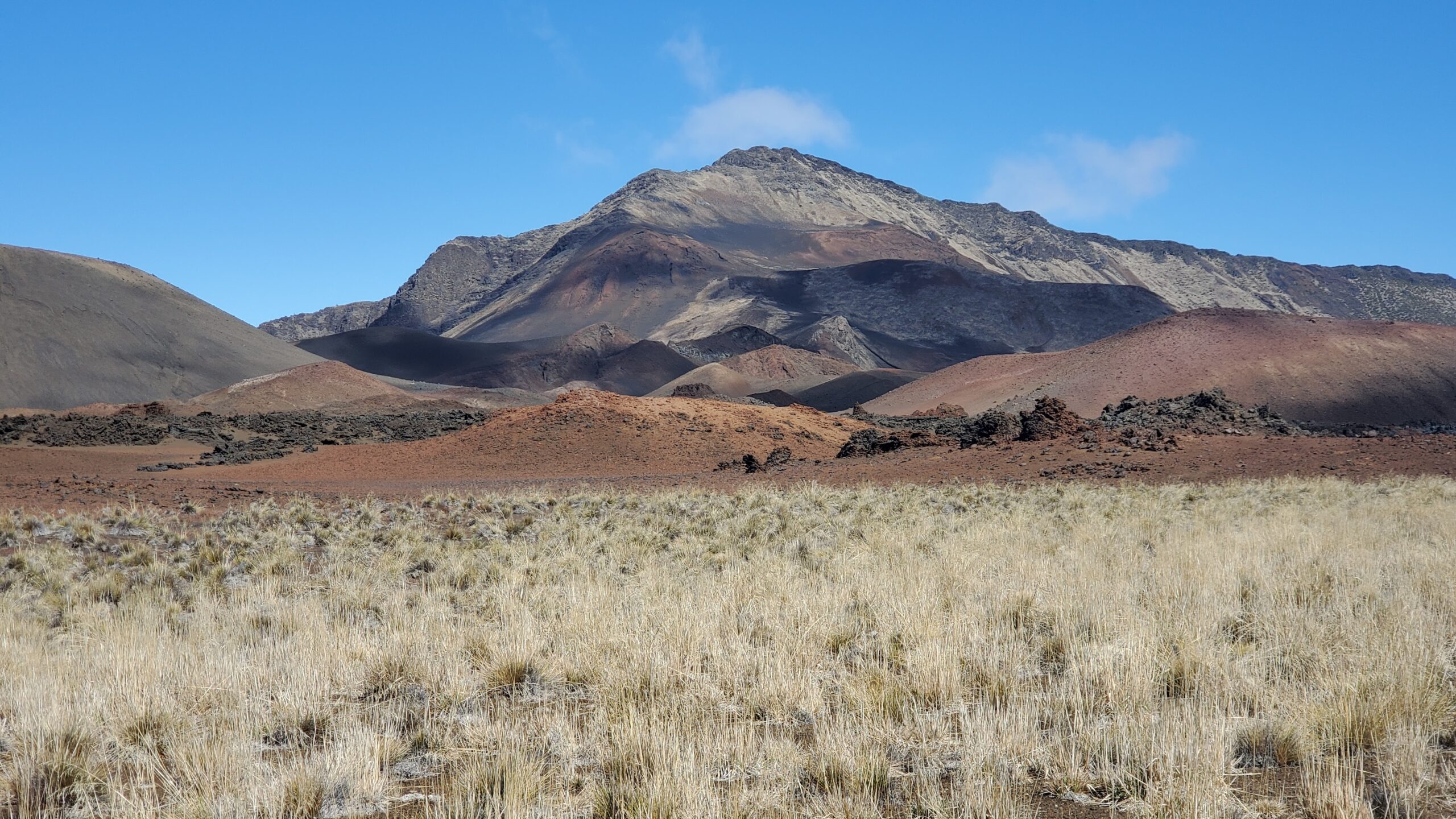
Right as we were beginning to approach Kapalaoa, we saw the former occupants of the cabin trekking off along one of the spur trails across the crater floor towards Halemau’u. Perfect timing! With no one else around, it meant that we could use the cabin as a rest-stop before heading out to Palikū campground.


Kapalaoa is one of three cabins in the Haleakalā crater and the only one that does not support adjacent backcountry camping. There was also a picnic table and surprisingly clean outhouse. At 5.6 miles from the trailhead, overnighting at this cabin would make for a reasonably easy hike-out day for the average hiker. We reached the cabin in about 3.5 hrs after a very easy going pace.
We still had 3.3 miles to go to get to our campsite, and true to form, the trail junction signaled another change in ecology. The next 2 miles towards the ‘O’ilipu’u tuft cone traversed an old lava bed. Clouds and mist were also starting to roll in from Kaupo gap.






The temperature dropped quickly and suddenly, and we found ourselves needing to don all the warm layers from the summit that we had shed earlier in the day. With every hour of hiking, the topography and weather seemed to change significantly, making this trip feel like a series of discrete hikes all linked together. Whereas we were, not that long ago, wishing for a reprieve from the sandy soil, the uneven, rocky trail of this section had us yearning for it back.
It was hard to believe that we were still in the same National Park from earlier in the day. If felt like the only aspect that had remained consistent throughout was how well defined the trail continued to be.
We reached the intersection with the far end of the Halemau’u Trail at the base of ‘O’ilipu’u and found a flat, grassy spot to break. Joining us were the first of many inquisitive nēnē!




From here it was just over a mile to camp. We would have to backtrack this section on our way out, so weren’t as disappointed that the views were completely obliterated by the low clouds. We could only imagine what lay beyond as we blindly followed the trail through the white mist.
Before long, we had reached the final trail junction of the day and as if on cue the clouds parted giving us our first view of the eastern wall of Kaupo Gap. We made it to Palikū!



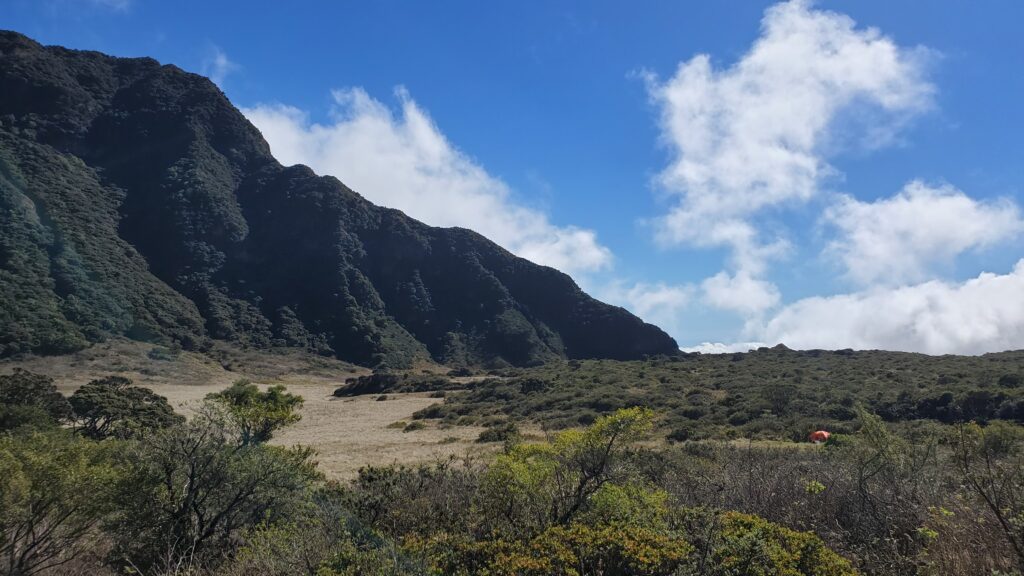
Read more trip reports from Haleakalā National Park
- Day 1: Hiking the Sliding Sands Trail to Palikū – that’s this trip report!
- Day 2: Exploring Palikū and Kaupo Gap
- Day 3: Hiking the Halemau’u Trail from Palikū to Holua
- Day 4: Hiking the Halemau’u Switchbacks Trail
Trip Planning and Logistics for the Sliding Sands Trail
The Keonehe’ehe’e (Sliding Sands) Trail is located within Haleakalā National Park, on the island of Maui. No permits or reservations are needed to day-hike any portion of this trail; reservations and permits are required to camp overnight in the backcountry. Standard park entrance fees of $30 apply, unless you have an America the Beautiful Interagency Pass.
Is the Sliding Sands Trail Worth it?
This is easily the most iconic trail in the summit region of Haleakalā National Park and we highly recommend you see at least a portion of it. The question is not “is it worth it” (that’s easy: absolutely!) but rather how much of the Keonehe’ehe’e (Sliding Sands) Trail you should hike. That depends as much upon logistics as it does physical ability.
Parking at the summit Visitor Center trail head allows you to get some phenomenal views while maintaining full control over the difficulty of your hike. Those wishing to maximize scenic viewpoints while minimizing the high altitude hiking required could walk a short distance along the initial arc of the trail without straying too far away from the parking lot (and other people) for safety.
Those with greater stamina for uphill elevation could create an approximately 4 mile out and back to the silversword grove. This option has significantly more elevation gain/loss but hits the highlights of the trail.
Well prepared hikers looking for a full day on trail and option to experience multiple ecosystems would want to consider the Sliding Sands – Halemau’u Loop. This point to point hike requires either a shuttle system between trailheads (two cars, one at each trail head) or a reliance upon hitchhiking within the park. In our opinion, this is the only reason not to do a point-to-point if you have the experience and ability to complete a hike all the way into the base of the crater and out; the ‘loop’ is much more scenic than backtracking up to the Sliding Sands Trailhead.
What to Pack for the Sliding Sands Trail
The weather in Haleakalā National Park can be unpredictable, and conditions at the summit when you arrive may differ significantly from conditions a few hours later. As with all high altitude hikes, the key to safe and enjoyable trip lies in proper preparation.
For our hike, which began shortly after sunrise in late November, we started the hike with multiple layers: I had on a long sleeve wool base layer underneath a down jacket, shorts, and hiking boots. Andras runs a bit warmer than me and was dressed in his equivalent of long sleeve base layer and long sleeve outer jacket. Our outer layers started coming off as the day progressed, but when the clouds started rolling in we were thankful to have our rain gear handy.
You should bring:
- Warm outer layer. It’s cold at the summit, even when it’s warm on the coast.
- Light weight rain jacket or windbreaker. Those clouds that were rolling in towards the end of our hike were carrying rain, but before that they brought the winds. Having a rain resistant/wind jacket will give you extra warmth if the weather turns unexpectedly foul while you’re in the middle of the crater.
- Sand gaiters. It comes as no surprise that a trail named “Sliding Sands Trail” has a lot of sand. Some of this sand is pointy and jagged. None of it feels good inside your shoe. A pair of running gaiters or sand gaiters will prevent innumerable stops to get out whatever just got kicked into your shoe out of it.
- Extra water. It is recommended to drink twice as much water at high elevation than at lower elevation and there is no potable source of drinking water in the crater. Even the water at the cabins and campgrounds needs to be filtered, and occasionally runs dry. Water is heavy, but add to uphill elevation to hike out, and the potential for hot, dry weather, and the the risk of dehydration increases. Carry at minimum of 2L per person if you are hiking down to the silverswords.
- Sunscreen. UV rays are stronger at higher altitudes because the atmosphere is thinner. Apply sunscreen before you go and carry some to reapply as needed throughout the day.
- Sun protection. You won’t want to forget sunglasses and a hat to shield your head, neck and face from the sun’s ultraviolet rays.
- A map of the trail. No one ever plans to get lost, and the Keonehe’ehe’e (Sliding Sands) Trail is well traversed and easy to distinguish from the surrounding landscape. But even if you aren’t hiking a long distance, a map that indicates the names and locations of different features will help you appreciate the special Hawaiian landscape you’re hiking in all that much more.
Have you hiked the Sliding Sands Trail or have questions in preparation for an upcoming trip? Let us know in the comments below.

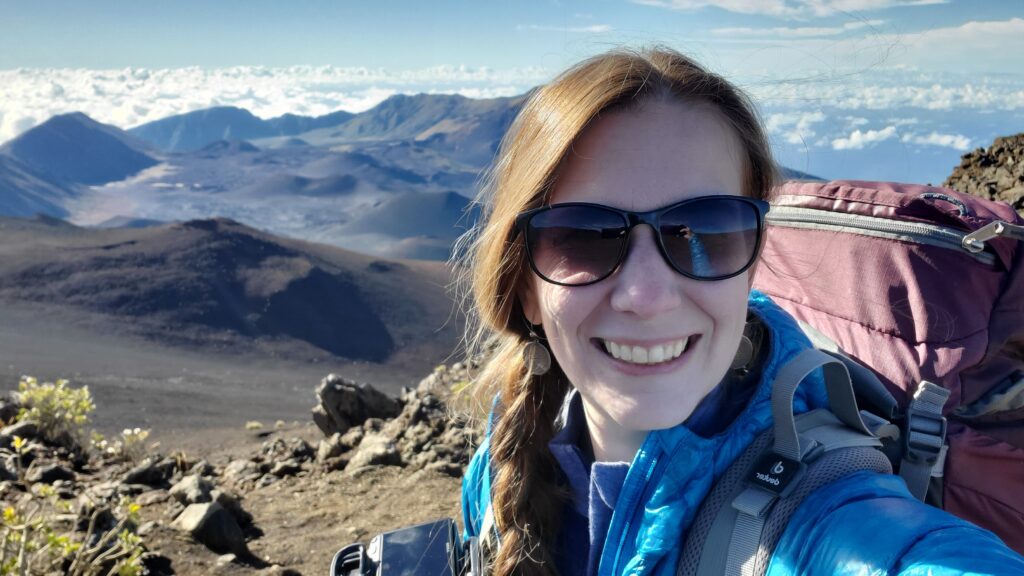

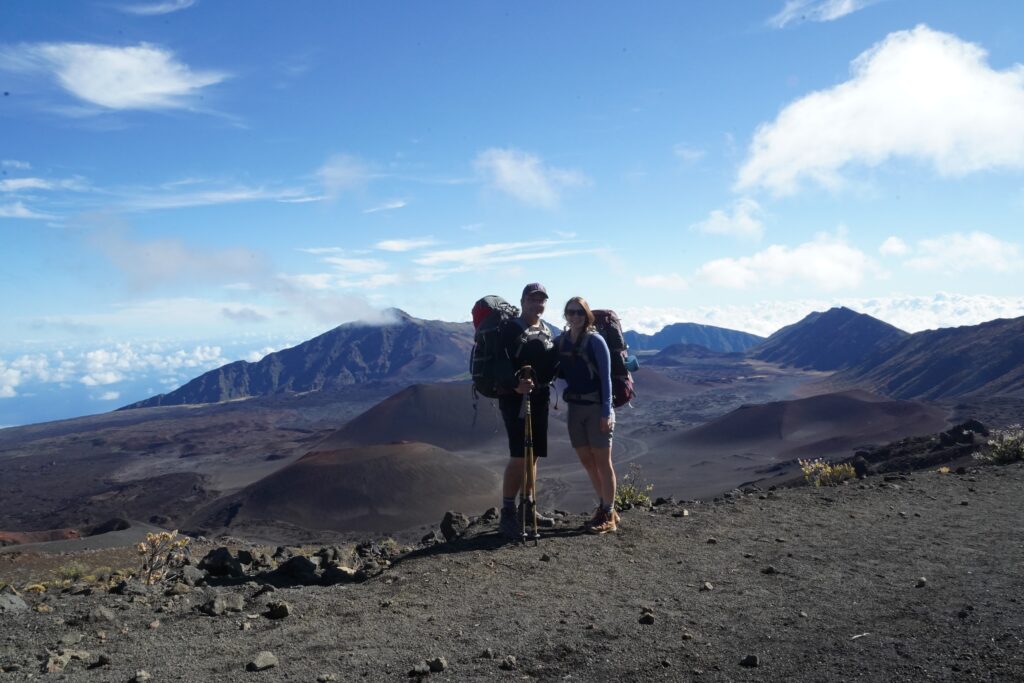
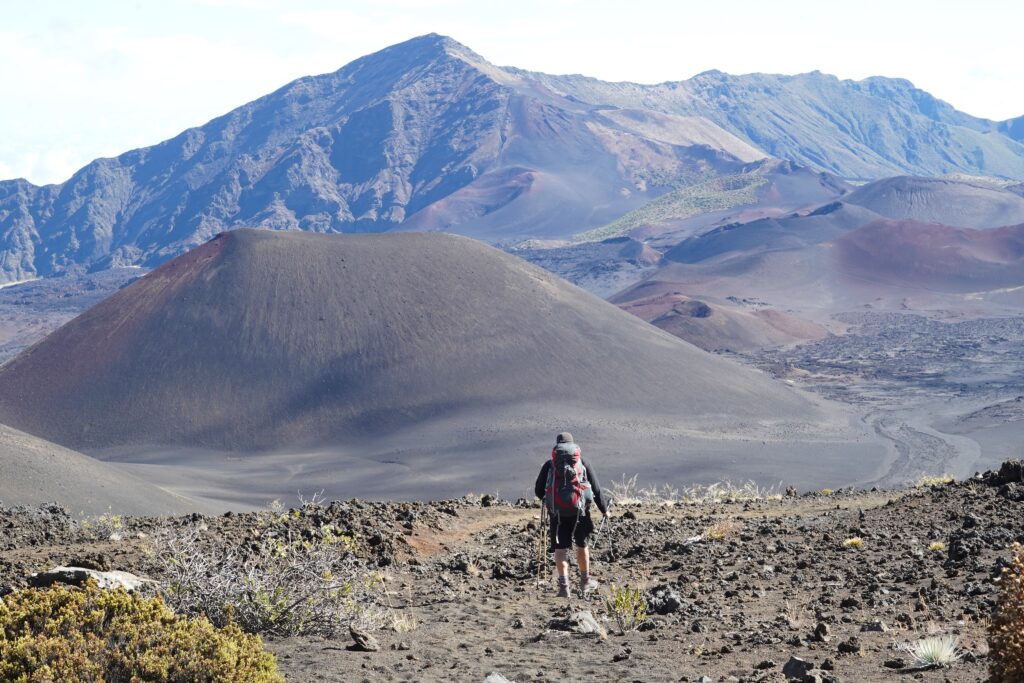

1 Comment
Nice write up. I could imagine myself hiking along with you!